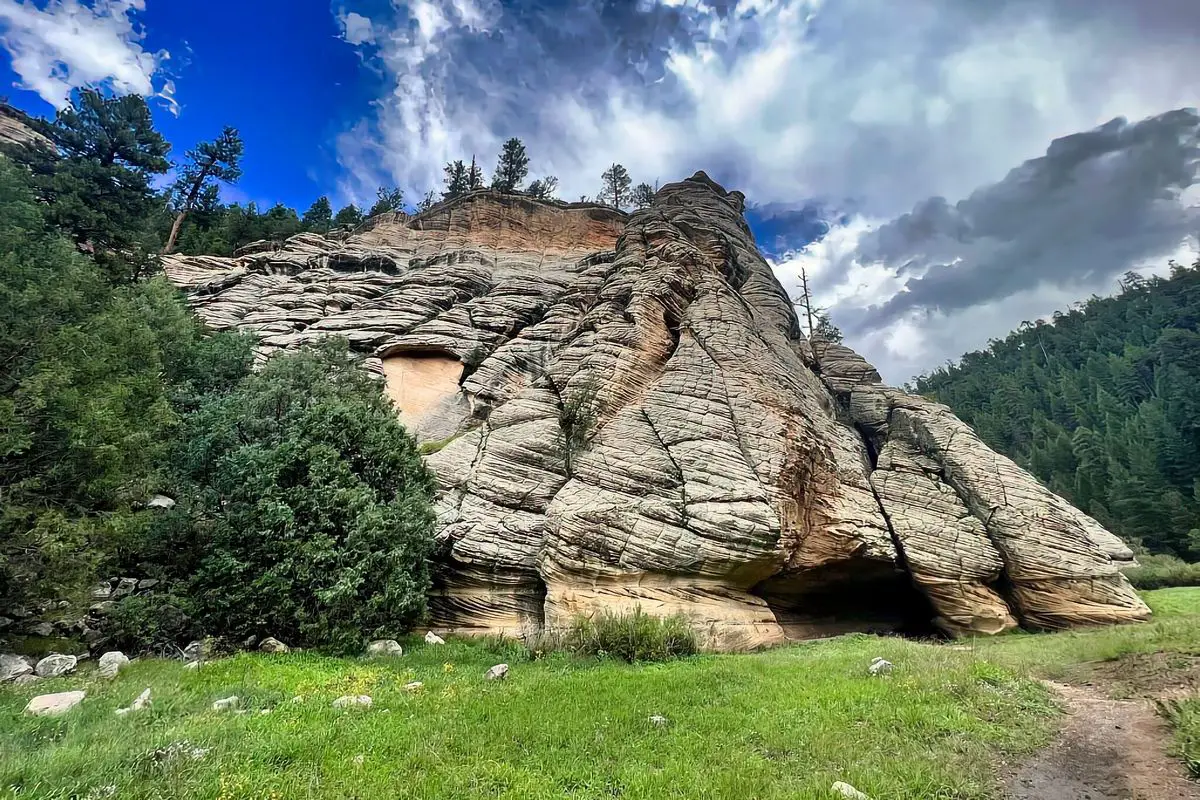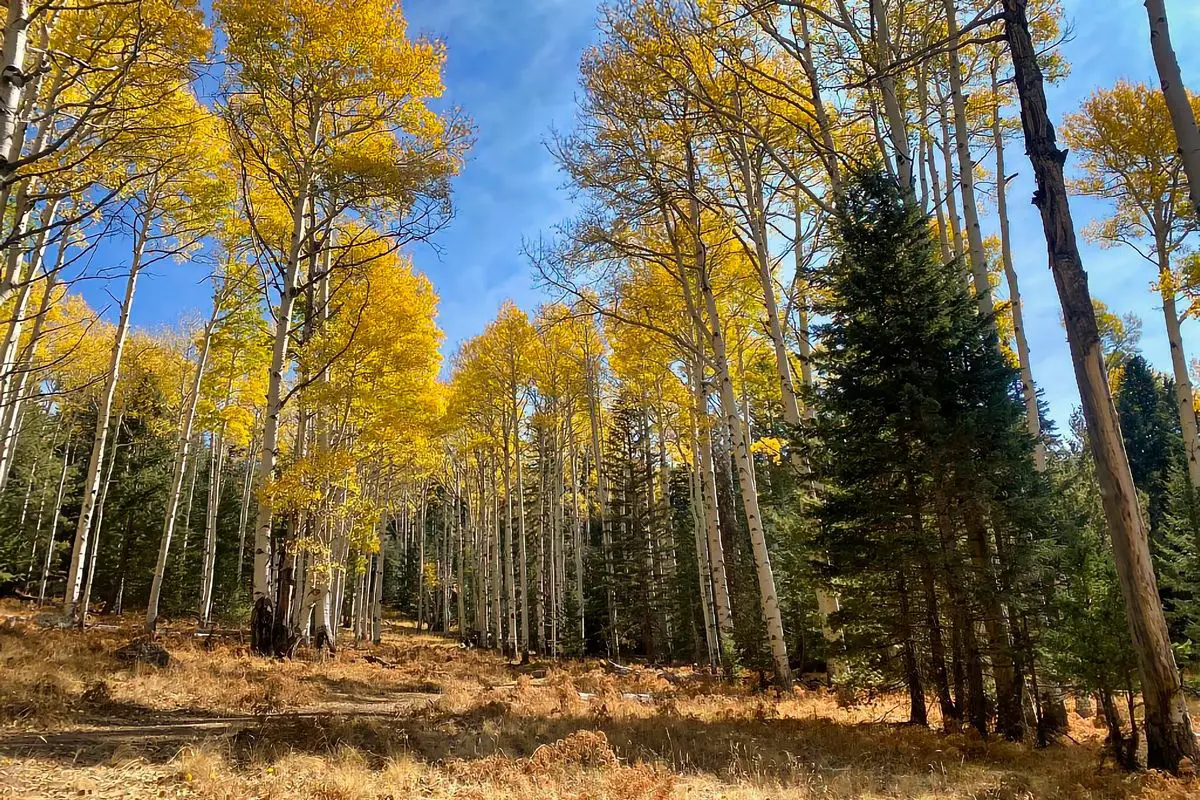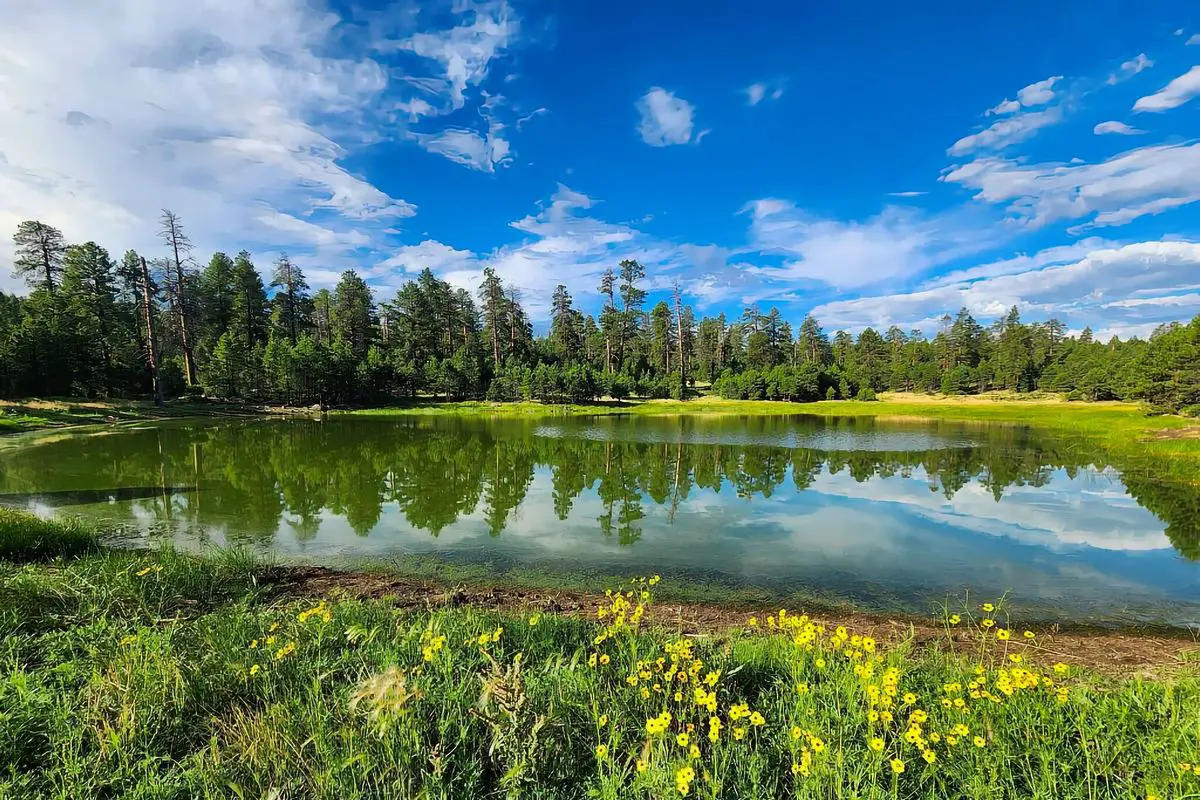If you want to experience free camping in Flagstaff,, you have plenty of excellent options. Free camping in Flagstaff is especially popular because the Coconino National Forest surrounds the city and offers many dispersed camping sites that don’t require any permits or fees. Free camping in Flagstaff lets you explore the outdoors without the cost of a traditional campground, making it a top choice for budget-minded campers.
You’ll find camping in Flagstaff tucked in the pines, spread out along forest roads, and even close to popular trails and attractions. Most free camping in Flagstaff is first-come, first-served, allowing you to enjoy cool mountain air during Arizona’s hot months. Remember to bring everything you need for free camping in Flagstaff—these areas don’t have water or amenities, so preparation is essential.
Whether you’re in a tent, van, or RV, free camping in Flagstaff gives you easy access to hiking, mountain biking, and the city’s downtown. You can wake up right in nature and enjoy everything northern Arizona has to offer, all without paying for a site. Free camping in Flagstaff is a gateway to adventure and relaxation.

Top Areas for Free Camping in Flagstaff, Arizona
Flagstaff, Arizona offers several excellent options for free dispersed camping, with sites ranging from quiet forest spots to open areas for off-highway vehicles. Free camping in Flagstaff means you can choose from a variety of environments, access rules, and amenities, depending on your camping style.
Walnut Canyon Dispersed Camping
Walnut Canyon Dispersed Camping is close to Walnut Canyon National Monument and sits within the Coconino National Forest. Free camping in Flagstaff at Walnut Canyon was popular in the past, but is currently closed until 2025 due to forest service restrictions. This area was favored for its proximity to the monument’s cliff dwellings and hiking trails, as well as easy access from Flagstaff.
If the area is open during your visit, you must stay at least 200 feet from water sources and roads. There are no services, so for free camping in Flagstaff here, you’ll need to bring all your water, food, and supplies. The roads are usually accessible to standard vehicles, but some pulloffs need high clearance, and the scenery is pine forest with shade and privacy if you drive further from the main road.
Always follow current forest rules, check closures, and pack out all your trash when camping in Flagstaff. Bear activity is possible, so store food securely. Free camping in Flagstaff at Walnut Canyon can offer a peaceful experience when open, especially if you want to visit Walnut Canyon National Monument or enjoy day trips into Flagstaff.
Freidlein Prairie Dispersed Camping
Freidlein Prairie Dispersed Camping offers a quieter alternative, about 15 miles from downtown Flagstaff in the Coconino National Forest. Free camping in Flagstaff here means sites are well-spaced and shaded by ponderosa pines, offering more privacy than many other free camping areas.
Getting to the campsites involves driving a rough dirt road, so a high-clearance vehicle is recommended. There are usually around 10-14 sites available on a first-come, first-served basis, and some sites might be closed seasonally due to nesting owls or local wildlife such as deer. Free camping at Freidlein Prairie is a solid choice if you want true seclusion and a scenic forest experience.
There are no amenities, including water or trash service, so come fully prepared for dry camping. Fire restrictions vary throughout the year, so check current alerts and always use a camp stove if fires are not allowed. Camping in Flagstaff at Freidlein Prairie is ideal for those seeking solitude and a natural setting.
Forest Service Road 171 Sites
Forest Service Road 171 runs northwest of Flagstaff and features many free dispersed camping sites in a mix of wooded and open landscapes. Free camping in Flagstaff along FR 171 is popular among boondockers and RV travelers due to easy access and large, flat spaces.
The road is gravel but can get muddy or rutted, especially after storms, so a 4WD or high-clearance vehicle can be helpful. Camping rules are typical for national forest land: stay at least 200 feet from water and roads, and obey posted signs. Free camping in Flagstaff at FR 171 offers plenty of room between neighbors, making it a good option for solitude or group camping.
No facilities are provided, so pack everything out and bring enough water. The sites are close to Flagstaff and major highways, making free camping in Flagstaff here convenient for exploring the area, visiting the Kachina Peaks Wilderness, or using the location as a base for outdoor activities.
Cinder Hills OHV Area
The Cinder Hills OHV Area is northeast of Flagstaff and offers free dispersed camping with a unique twist: it is designed for off-highway vehicle users. Free camping in Flagstaff at Cinder Hills means camping on black cinder soil from ancient volcanic eruptions, making the area popular for riding ATVs, dirt bikes, and other OHVs.
You can camp anywhere that is 200 feet from trails and water sources. There’s plenty of room for tents, trailers, and RVs, but the surface is usually loose and rocky, and large flats give wide views of nearby Humphreys Peak and the San Francisco Peaks. Free camping in Flagstaff at Cinder Hills is remote and off-grid, perfect for campers who enjoy outdoor recreation and want to explore the volcanic landscape of the Coconino National Forest.
There are zero facilities and no water, so you must come fully prepared. Be aware of fire danger and follow all posted restrictions. The remote environment of free camping in Flagstaff at Cinder Hills makes it an exciting destination for adventure.

What to Expect When Free Camping Near Flagstaff
Free camping in Flagstaff puts you right in the middle of tall pine forests, cool mountain air, and wide-open views. The area offers dispersed camping across national forest land, so you need to be ready to camp without many services or facilities. Free camping in Flagstaff means embracing self-sufficiency and adventure in a beautiful setting.
Essential Packing List and Preparation
When you plan for free camping in Flagstaff, expect no water, no bathrooms, and no trash bins. Bring enough water for drinking, cooking, and cleaning, and make sure your supplies are adequate for free camping in Flagstaff. A sturdy tent, warm sleeping bag, and weather-appropriate clothes are necessary due to temperature swings.
Some camping tools you should have include:
| Item | Why You Need It |
|---|---|
| Map or GPS | For finding sites & trails |
| Portable stove or grill | No guaranteed campfire allowed |
| Cooler | To keep food fresh |
| First aid kit | For minor injuries |
| Trowel and trash bags | For Leave No Trace practices |
There’s no cell service in many areas, so download maps and guides in advance. If you bring pets, remember leashes and extra water for them while free camping in Flagstaff.
Weather and Best Seasons
Flagstaff sits at almost 7,000 feet, close to the San Francisco Peaks. Nights can get cold, even in summer, so free camping in Flagstaff requires packing for varying temperatures. July and August bring afternoon storms and possible mud, while April through October offer the best camping conditions for free camping in Flagstaff.
Summer: Days are mild (70s-80s°F), but nights are cool or chilly.
Spring/Fall: Weather is changeable—pack clothing for both warm days and freezing nights.
Winter: Snow is common, making roads hard to pass and camping risky unless you’re experienced.
Always check for fire restrictions before your trip, especially during dry months. Quick weather changes are normal, so bring rain gear and extra layers to stay comfortable while free camping in Flagstaff.
Permits, Rules, and Stay Limits
Most free, dispersed camping near Flagstaff does not require permits or fees. You can stay on Coconino National Forest land, but follow local rules for free camping in Flagstaff. The usual stay limit is 14 days in a 30-day period in one spot, so plan your free camping in Flagstaff accordingly.
Camp only in established spots and obey any area closures. Recent fire damage and new rules mean some areas—like Schultz Pass Road—are closed to camping. Campfires may be banned during high fire danger; use a camp stove for cooking while free camping in Flagstaff.
Always pack out all trash, follow Leave No Trace guidelines, and do not camp too close to water sources or the Arizona Trail. For the latest updates or restrictions, it’s smart to check with the Flagstaff Ranger District before your free camping in Flagstaff trip.

Exploring Attractions Around Flagstaff Campsites
Free camping in Flagstaff puts you close to several natural landmarks and unique landscapes. From volcanic craters to sandstone formations and historic pueblos, you’ll find plenty of things to do nearby while enjoying free camping in Flagstaff. These attractions make free camping in Flagstaff even more rewarding.
Sunset Crater Volcano National Monument
Sunset Crater Volcano National Monument protects a cinder cone volcano that erupted around 900 years ago. You can walk short or longer trails across fields of black lava rock and bright cinders while free camping in Flagstaff. The Lava Flow Trail offers accessible pathways and signs to help you learn about past eruptions and their impact on the land.
Aspens and Ponderosa pines grow in the higher areas around the crater. Spring and fall are especially pretty, when wildflowers or golden aspens stand out against the dark volcanic soil. The park does not allow hiking to the summit of the crater itself to help prevent erosion, but several nearby trails offer good views and photo spots for those free camping in Flagstaff.
Here is how you can enjoy your trip:
| Activity | Details |
|---|---|
| Hiking | Lava Flow Trail, Lenox Crater Trail |
| Visitor Center | Exhibits, info, restrooms |
| Picnic Areas | Tables available near parking lots |
| Scenery | Volcanic fields, aspens, mountain views |
Wupatki National Monument
Just north of Flagstaff, Wupatki National Monument features ancient pueblos built by Native Americans around 900 years ago. The main attraction is the Wupatki Pueblo, a large sandstone structure with rooms and unique features like a ball court and ceremonial circle. Free camping in Flagstaff makes it easy to visit these historic sites.
You can take a self-guided tour of the main pueblo on a paved path. Several smaller ruins, including Lomaki and Wukoki, are accessible by short walks. The open high desert landscape gives you clear views of the San Francisco Peaks in the distance while free camping in Flagstaff.
Wildlife in the area includes lizards, jackrabbits, and birds. Bring water and sunscreen, as the site can be hot and dry, especially in summer. Free camping in Flagstaff gives you a convenient base for exploring Wupatki and other cultural treasures.
Sedona and Surrounding Scenery
From Flagstaff campsites, you can reach Sedona in just under an hour by car. Sedona is famous for its red rock formations, scenic overlooks, and hiking trails like Cathedral Rock and Bell Rock. Free camping in Flagstaff provides easy access to all of Sedona’s attractions.
You can enjoy activities like photography, hiking, mountain biking, and exploring the shops and restaurants in Sedona’s town center. The Oak Creek Canyon drive between Flagstaff and Sedona is especially scenic, with sharp turns, rocky cliffs, and tall aspens lining the road in some sections. Free camping in Flagstaff lets you experience the best of both regions.
Some popular sights and activities:
- Sedona Red Rocks: Stunning rock formations for viewing and exploring
- Oak Creek: Picnic spots, swimming holes, and shaded hikes
- Aspen Trees: Visible along certain trails, especially during fall color season
- Art Galleries: Many local galleries and studios in town
Sedona also offers easy access to other nearby points of interest, including hiking hotspots and beautiful overlooks. Free camping in Flagstaff is the perfect way to explore Sedona and the surrounding scenery.
Tips for Responsible and Enjoyable Boondocking
Boondocking around Flagstaff means respecting nature, following the rules, and knowing your route. Free camping in Flagstaff is only sustainable when everyone protects the forests and stays safe on rough roads. Practice good habits to ensure free camping in Flagstaff remains available for years to come.
Leave No Trace and Fire Safety
When boondocking in the Coconino National Forest or along places like Cosnino Road, always follow Leave No Trace principles. Pack out all of your trash—including food scraps and pet waste—and avoid leaving any sign that you were there while free camping in Flagstaff. Avoid creating new campsites and always use existing fire rings if available.
Fire safety is critical.
- Many areas near Flagstaff have seasonal fire bans, especially in the summer.
- Never start a fire during high fire risk warnings.
- If fires are allowed, keep them small and never leave them unattended. Completely extinguish your fire with water, not just dirt, before you leave.
Camp stoves are a safer option for cooking. Report any smoke or signs of wildfire right away and check with the local ranger district for the latest restrictions. Free camping in Flagstaff is more enjoyable and sustainable when everyone does their part to protect the land.
Road Conditions and Vehicle Considerations
Some popular free camping spots near Flagstaff, such as Cosnino Road and back roads in the Coconino National Forest, may have rough or washed-out sections. Many forest roads used for free camping are not paved or maintained, making free camping more challenging during certain seasons. After rain, these roads can become muddy and hard to pass, which is important to consider for free camping enthusiasts.
A high-clearance vehicle or 4WD can be helpful for free camping in these areas, and sometimes it is even required. If you plan on free camping with a small car, you may not make it far from the main road, so plan accordingly. When free camping, always take it slow and avoid driving over plants or making new tracks, as this damages the fragile landscape and can impact future free camping opportunities.
It is essential to bring a paper map or offline GPS when free camping near Flagstaff, since cell service is spotty or unavailable in many free camping locations. Before heading out for free camping, check road status with the Forest Service, especially during rainy seasons, to avoid getting stuck. Free camping requires extra preparation, so always ensure you have backup navigation and up-to-date information for a safer free camping experience.
Free camping near Flagstaff offers beautiful scenery and solitude, but the condition of the roads can change quickly. Always be prepared for the unexpected when free camping, as weather and road conditions can shift rapidly. Responsible free camping helps preserve these areas for everyone who wants to enjoy free camping in the future.
If you are new to free camping, consider starting on well-traveled roads before venturing deeper into the forest. Free camping can be rewarding, but it comes with challenges that require careful planning and the right equipment. By respecting the environment and following guidelines, you can make the most of your free camping adventure near Flagstaff.


You must be logged in to post a comment.